UPDATE: Now over. Thanks for visiting!
Q: Where in the world would you find an elephant, a sea turtle and an axolotl all together?
A: In Species in the Sand, the new sand sculpture this summer at Point Defiance Zoo & Aquarium!
Beginning mid-May, our sculpting team led by Tacoma native Sue McGrew will return to create another incredible sculpture – this time, highlighting endangered species that live right here at Point Defiance Zoo & Aquarium.
“We have a large number of critically endangered species in our care at Point Defiance Zoo that we are working to protect for future generations,” explains Wendy Spaulding, conservation engagement curator. “We hope that seeing these precious species all together in one of Sue’s amazing sculptures will inspire guests to join us in taking action on behalf of endangered wildlife, big and small.”
It’s also great timing: the sculpting kicks off on May 17, World Endangered Species Day.
Sculpting a message
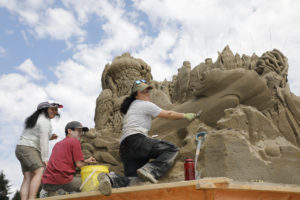
The sculpture will also be a ton of fun for McGrew, back in town after a year of international sand sculpting.
“I’m so excited about coming back,” says McGrew, who’ll be joined by Tacoma sculptor Jeff Strong and California sand artist Abe Waterman. “It was such a blast last year. A lot of the time I don’t have much public interaction when I sculpt, like the piece I just did at a sand museum in Japan. It’s under cover so I get to do something really big that lasts year-round. But I just go in, work and then leave. At the Zoo I get to talk to people and share the joys of sculpting sand. It’s so great.”
To plan the design, Spaulding sent a list of endangered species cared for at the Zoo. These included green sea turtles, scalloped hammerhead sharks, Asian elephants, Sumatran tigers, Malayan tapirs, siamangs, clouded leopards, red wolves, tufted puffins and more – plus several plant species like the dawn redwood and monkey puzzle tree. All are species at risk of extinction.
Land and Sea
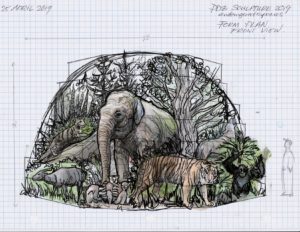
McGrew thought hard about how to combine so many types of animals – large, small, land and sea – in the one sculpture. Unlike last year’s Pacific Seas Aquarium sculpture, she decided to go in a more dreamlike, stylized direction, taking liberties with relative size and weaving all the species into a swirl that peaks at the top into tree branches on one side, ocean waves on the other.
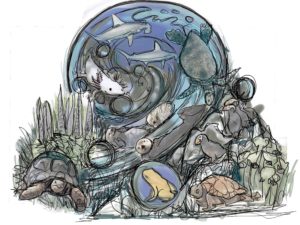
On the land side, the central focus will be an Asian elephant – “They’re so bold and majestic, so striking visually, and also it’s so tragic what’s happening to them with poaching,” explains McGrew. Surrounding the elephant will be anoas, tigers and even an axolotl, a small amphibian with feathery sides that lives in Kids’ Zone.
On the water side, a swirling wave contains warm-water species like a green sea turtle and scalloped hammerhead shark (viewable in the Pacific Seas Aquarium), plus sea otters, puffins on rocks and even a golden poison arrow frog, magnified in size.
How it’s done
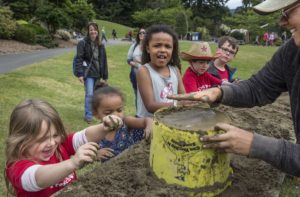
Sand sculpting always starts with wetting and compacting into blocks, and McGrew will be at the Zoo for this in early May. Strong and Waterman will begin sculpting on World Endangered Species Day, May 17, working from the top down. McGrew will join them on Memorial Day weekend, and from June 1 they’ll also have help from McGrew’s sister Kathleen and sculptor Ryan Hirai.
When the sculpture is done, McGrew’s team will spray it with a thin layer of diluted glue to protect it from rain marks.
But it’s not just the sculpting team who gets to play in the sand. Like last year, sand stations and tools will be available all day for the public.
“Seeing it evolve from construction site to sculpture is pretty cool,” McGrew says. “Last year I even heard kids saying ‘Let’s go see the animals,’ and the parents would respond, ‘No, I’m not done yet!’”
It’s this fascination with sand, says McGrew, that makes it so ideal for telling stories – like how endangered species urgently need our help.
“You say sand, people think ‘beach,’” she says. “But our entire civilization is built on sand: our buildings, roads, glass, technology. It’s an incredible resource that we turn into other things. It becomes so strong, yet we play with it on the beach as kids. It has this magical quality people can really relate to.”
Helping species survive
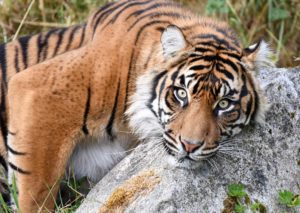
Point Defiance Zoo is home to 18 endangered animal and 5 endangered plant species, plus many more that are listed as threatened or vulnerable. It is a national leader in Species Survival Plan breeding programs for clouded leopards, Malayan tapirs and Sumatran tigers, and supports many conservation projects to protect endangered species in the wild through the Dr. Holly Reed Wildlife Conservation Fund.
Want to help endangered species? Look on our Take Action webpage for ideas like eating sustainable seafood, buying sustainable palm oil to protect rainforests, minimizing your plastic use to help ocean animals and more.
SEE IT: Sculpting kicks off May 17 and continues through June.
DO IT: Sand play stations will be available daily through summer.
LEARN MORE: Read about Sue McGrew in our 2018 sand sculpture story.